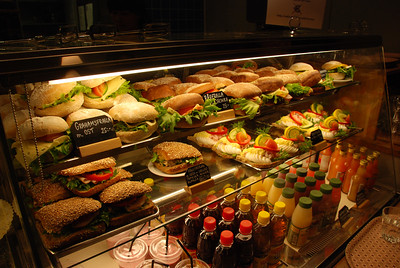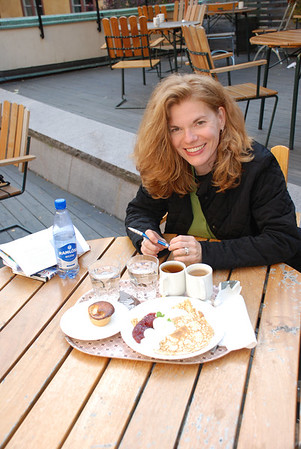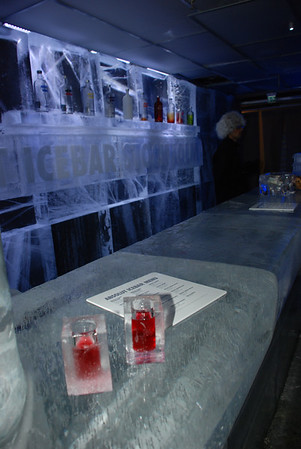In flawless English the waiter announced that Cafe Nova’s daily lunch special consisted of spinach-and-feta quiche, mixed greens, a multigrain roll and glass of lingonberry juice. Were it not for that tart, red fruit juice, unique to Scandinavian cuisine, I could have been dining in any Western country. I was, though, seated at an outdoor cafe in the Swedish capital of Stockholm.
Although home to such industries as Volvo, Saab, and IKEA and such entertainment icons as Ingrid Bergman, Ingmar Bergman and ABBA, Sweden offers intrepid travelers far more than cars, home furnishings and ‘dancing queens.’ This beautiful, ecologically-minded nation possesses a delightful cuisine reflective of its simple, natural approach to living.
While in Sweden, my husband Sean and I had the luxury of staying and dining with a Stockholm resident. A friend from Columbia University’s J-school, Christina Anderson works as a press secretary for the Swedish International Development Cooperation Agency (SIDA). During our stay she also served as a personal chef, translator and tour guide. After years of struggling with different languages and dialects, of fumbling through menus, and overlooking so many cultural aspects, I was delighted to have an insider’s perspective and assistance. It goes without saying that I also was overjoyed to catch up with an old friend.

Christina quickly clued us in on the exorbitant cost of food. On our first night in Stockholm the three of us went out for Italian near her neighborhood of Maria Prastgardsgatan. Three plates of cannelloni al funghi and a bottle of the cheapest house red wine set us back $140. And people complain about New York being expensive.
In spite of high prices we indulged an array of uncomplicated Swedish delicacies. At the outdoor organic cafe in Djurgarden City Park Christina and I slurped down bowls of velvety mangold soup. Similar to kale, the pureed mangold made a nutritious and savory repast. At a quaint cafe across from the Nobel Prize Museum we nibbled on open-faced shrimp sandwiches and coconut-covered chocolate balls. On the Viking island of Gotland we dined upon savory crepe-like pancakes filled with wild mushrooms and sweet dessert pancakes topped with preserves and homemade whipped cream.

Breakfasts we usually ate at Christina’s. Strongly brewed coffee lightened by warmed milk, slices of fresh, brown Danish bread and wedges of dark Norwegian cheese started our mornings. When in the ancient village of Visby on the island of Gotland, the bread and cheese were accompanied by hard boiled eggs and little blue tubes of Kaviar paste.
We could not leave Sweden without imbibing in a bit of aquavit. Similar to vodka, this Scandinavian classic is distilled from potatoes or grain then infused with spices and herbs such as caraway, fennel and coriander. It can be swigged down as a shot, nursed like a fine whisky or chased by a beer.
Likewise, we didn’t want to depart without engaging in the ultimate tourist activity — drinking at the Ice Bar. Run by Absolut and housed in the Nordic Sea Hotel in downtown Stockholm, the Ice Bar lived up to its name. The entire structure — walls, counter, tables, seats, glasses and shelves — consisted of ice. Kept at a brisk 23 degrees Fahrenheit, the bar featured an array of vodka-based cocktails mixed by parka-clad bartenders. My favorite, Absolut Wilderness, consisted of raspberry vodka, lingonberry juice and apple sour and came in a small but chunky block of ice.

On our last night in Sweden Christina presented us with a feast of traditional foods. Following family recipes, she sauteed chanterelles with parsley, salt and “a click of butter,” mixed fresh lingonberries with sugar, tossed together a salad, toasted bread and made pancakes accompanied by blueberries, Turkish yogurt and confectioner’s sugar. What a wholesome and delicious going away gift!
As a parting present, Christina slipped a jar of organic cloudberry preserves and Vilmas rosemary knackebrod, or “crispy bread,” into my backpack. In Sweden the amber-colored cloudberries frequently top waffles, ice cream or pancakes. The hand-baked, rye-laced flatbread often acts as a healthful substitute for biscuits and crackers. While cloudberry preserves can be procured online as well as at Fairway in New York, Vilmas knackebrod can only be obtained in Sweden and in select shops in Belgium and the Netherlands. For information on Vilmas, check out http://cartwright.se/.
Glogg or Yuletide Mulled Wine
Courtesy of Triberg, Ranung and Hagman and the “Very Swedish” cookbook.
Serves 4 to 6
Ingredients:
10 cl vodka
5 sticks of cinnamon
20 cloves
fresh ginger, peeled and cut into slices
1 teaspoon cardamom
½ Seville orange peel
1 bottle red wine
2 tablespoons granulated sugar
In a mortar crush the cinnamon, cloves, gingers, cardamom and orange peel. Transfer to a bowl, jar or small pitcher and pour the vodka over it. Cover and let stand for 12 to 24 hours.
Strain through a sieve lined with cheese cloth or a coffee filter.
Pour the wine and two sugars into a large saucepan. Heat (do not boil) until sugars have melted. Add the vodka mixture, stir and serve.